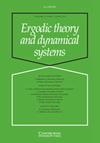施密特博弈和康托尔胜局
IF 0.8
3区 数学
Q2 MATHEMATICS
引用次数: 0
摘要
施密特博弈和康托获胜属性给出了大的另一种概念,类似于更标准的度量和范畴概念。它们直观、灵活,而且适用于最新研究,因此成为研究的热点。我们对最常见变体的定义和它们之间的联系进行了调查。我们还发明了一种新的游戏--康托尔游戏,它有助于提出一个统一的框架。我们证明了一些令人惊奇的新结果,如在度量空间中绝对胜局和$1$ Cantor胜局的重合,以及$1/2$胜局意味着$\mathbb {R}$ 子集的绝对胜局。我们还提出了一个康托胜出集的原型例子,以说明这种集在公设数论和遍历理论中无处不在。本文章由计算机程序翻译,如有差异,请以英文原文为准。
Schmidt games and Cantor winning sets
Schmidt games and the Cantor winning property give alternative notions of largeness, similar to the more standard notions of measure and category. Being intuitive, flexible, and applicable to recent research made them an active object of study. We survey the definitions of the most common variants and connections between them. A new game called the Cantor game is invented and helps with presenting a unifying framework. We prove surprising new results such as the coincidence of absolute winning and $1$ Cantor winning in metric spaces, and the fact that $1/2$ winning implies absolute winning for subsets of $\mathbb {R}$ . We also suggest a prototypical example of a Cantor winning set to show the ubiquity of such sets in metric number theory and ergodic theory.
求助全文
通过发布文献求助,成功后即可免费获取论文全文。
去求助
来源期刊
CiteScore
1.70
自引率
11.10%
发文量
113
审稿时长
6-12 weeks
期刊介绍:
Ergodic Theory and Dynamical Systems focuses on a rich variety of research areas which, although diverse, employ as common themes global dynamical methods. The journal provides a focus for this important and flourishing area of mathematics and brings together many major contributions in the field. The journal acts as a forum for central problems of dynamical systems and of interactions of dynamical systems with areas such as differential geometry, number theory, operator algebras, celestial and statistical mechanics, and biology.

 求助内容:
求助内容: 应助结果提醒方式:
应助结果提醒方式:


